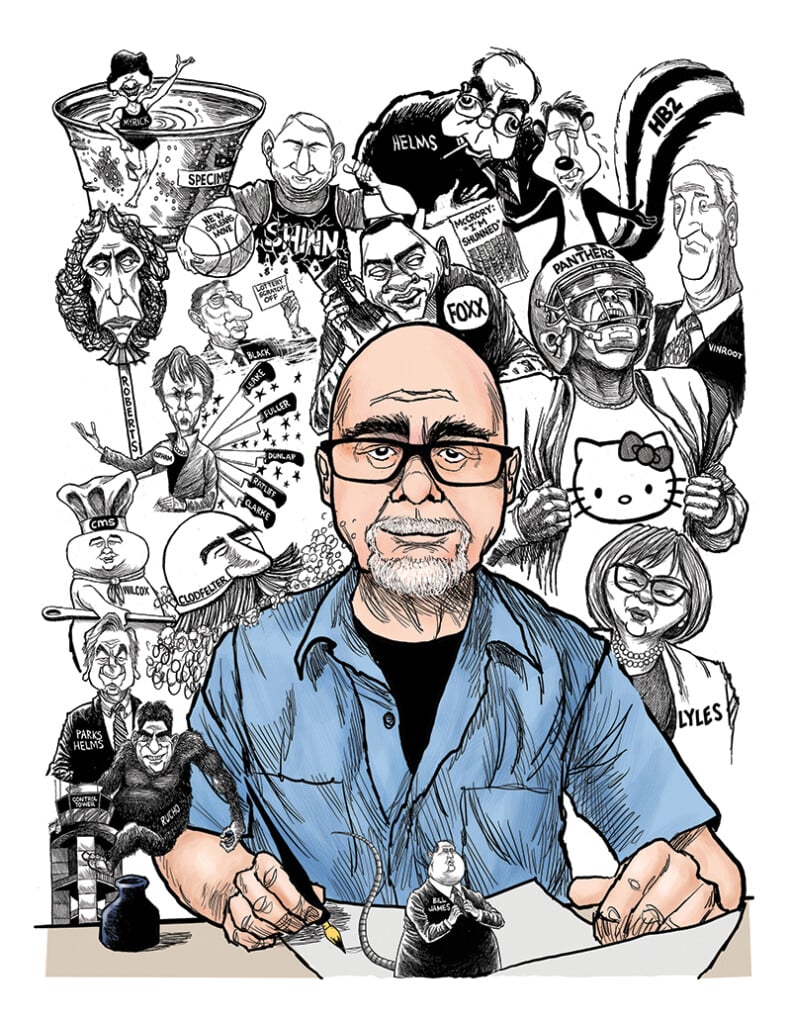2023 Charlotteans of the Year: Kevin Siers
His layoff after 36 years as the Observer’s editorial cartoonist muted one of our strongest voices

On June 10, 2019, The New York Times announced that it would no longer publish daily political cartoons in its international editions and cut ties with a pair of its cartoonists. A recent cartoon of Donald Trump and Benjamin Netanyahu had drawn accusations of antisemitism. Kevin Siers, the longtime editorial cartoonist at The Charlotte Observer, responded to this news the way you’d imagine.
Siers’ cartoon shows a morose man who holds a copy of the Times with everything but the masthead and “All the News That’s Fit to Print” box cut away, leaving a massive empty space. Siers captioned it: “If The New York Times responded to complaints about its stories and columns the way it responded to complaints about editorial cartoons …”
Siers has never faced complaints that severe. But since the Observer hired the Minnesota native in 1987, he has irked readers at every point on the political spectrum, applying a cartoonist’s skewer to presidents, Charlotte City Council members, business leaders—potentially anyone in the public eye. That’s been the role of newspaper cartoonists since the 19th century, when Thomas Nast, “the Father of the American Cartoon,” took aim at “Boss” Tweed and Tammany Hall.
This July, the company that owns the Observer decided it no longer had room for Siers and two other editorial cartoonists, Jack Ohman of The Sacramento Bee and Joel Pett of the Lexington Herald-Leader. All three had won Pulitzer Prizes. Siers, appropriately, chooses a cartoon image as a metaphor for his dismissal: “the Wile E. Coyote anvil falling on you.”
McClatchy, through Charlotte-based opinion editor Peter St. Onge, cited “changing reader habits and our relentless focus on providing the communities we serve with local news and information they can’t get elsewhere.” (St. Onge sends the following response when I reach out to him in October: “Kevin is a brilliant cartoonist and a Charlotte treasure. He also was a valuable, thoughtful member of our editorial board. I was proud to work with him.”) Media companies everywhere have made similar decisions these last few years: The day before Siers and I speak, his home-state paper, The Star Tribune in Minneapolis, announced that it had eliminated its full-time cartoonist position.
Siers says the news of his layoff “came out of the blue.” St. Onge sent him a text message the morning of July 11, telling him to join a Zoom call at 2 p.m. “I got sort of a sick feeling in my stomach,” he says. Speaking from his home in Salisbury, Maryland, where he moved with his wife last year, Siers emphasizes that he holds no grudge against anyone at the Observer. But he believes cartoonists deliver something essential to communities—sharp-witted voices that challenge power and readers’ preconceptions.
“Around the turn of the century, when Pulitzer and Hearst got into newspaper wars, the first thing they did was hire cartoonists and steal each other’s cartoonists and comic strips,” he says. “That was seen as a way to build readership—strong opinions that made an impact in the community. I worry that newspapers are shying away from the idea that they really want to make strong impacts or have strong voices.”
Siers is 69, and his layoff wasn’t a major financial blow for him. He and his wife, Jean, had discussed his retirement anyway, and he still draws three cartoons per week for Cagle Cartoons, a national syndicate that distributes political cartoons and columns. But they’re all about national politics. “It’s very different drawing for an amorphous national audience as opposed to people who see the paper every day or go online every day,” he says. “I don’t think Joe Biden’s going to see my cartoons like Phil Berger saw my cartoons, you know?”
So what else does a forcibly retired editorial cartoonist do when his career fades away? Siers spends time with his son and granddaughter, and he’s doing some painting. His life is good. We’re the ones who have lost something.
“Cartoonists can crystallize issues more powerfully and more succinctly than any editorial, and deliver these opinions with a one-two punch,” he says. “It’s one reason why readers enjoyed them so much—and continue to enjoy them.”
Greg Lacour is the editor.





